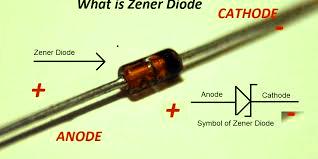What is Zener Diode.
Zener diode is a special type of diode whose reverse bias voltage discharge is an interesting characteristic. a steeply penetrating voltage with a current thereby making the voltage reference point somewhat stable when fed with a small range of reverse currents.
The term zener diode is applied to most inverted splitting devices, but the zener effect really only applies to diodes in the 5.1v range. others are only designed to be damaged at breakdown voltage.In addition to the voltage reference, they also make good voltage clamps to protect components from excessive stress.
Zener diode is popularly used as shunt regulator or voltage regulator. it is mainly the special property of the diode rather than the special kind of equipment. a person named zener permits created this property from the diode that is why it was named after his name as a dhikr. the special property of the diode is that there will be damage in the circuit if the voltage is applied in the reverse biased circuit. this does not allow current to flow over it. when the diode voltage increases, the temperature also increases and the crystalline ion vibrates with greater amplitude and all this leads to breakdown of the depletion layer. layer at junction type ‘p’ and ‘n’. when a given voltage exceeds a certain amount, zener damage occurs.
Uses.
Application: main application of zener diodes are as voltage regulator.
Zener diode is a diode that can allow current to pass through reverse and direct polarization.
It means that it has two threshold voltages, one to allow the current in one direction, the other to allow it in the other direction.
The general diode only allows the current to pass through it in one direction, and when it passes the threshold voltage.
You can use it as a voltage regulator.
We reverse the zener bias and like all diodes there is an inverse peak voltage (piv) rating and at this point when the diode is reverse the bias will do in the reverse direction, the current will flow in reverse direction.
We spec all diodes with piv rating and in circuits with most diodes we choose diodes that this voltage will not happen, select diodes with a piv that is high enough so that under normal operation the diode will not be reverse biased. also diodes have min piv, but may choose higher ones, like 1n 4001 has 50v piv, but this is min and one that you take out of lot maybe really have piv 60v. still you will not rely on this if the required circuit repair replacement diode may be 51 v piv, but can count on it being at least 50v.
However, zener diodes use this inverted piv as a specification for diodes. if it gets 18v zener then it is guaranteed to have 18v piv.
Then we can use this as a reference for power supply regulator, or even use zener as regulator. if like 8.2v zener and with resistor fed with 12v then the voltage at the zener will remain at 8.2 v which regulates the voltage. in small current demands that require constant steady voltage we can use zener to regulate voltage. we can also marry him with a larger transistor to provide a higher current regulator.
Basically the zener clamping the voltage across it and we can insert the zener in the circuit at the place where a constant regulated voltage is required.


